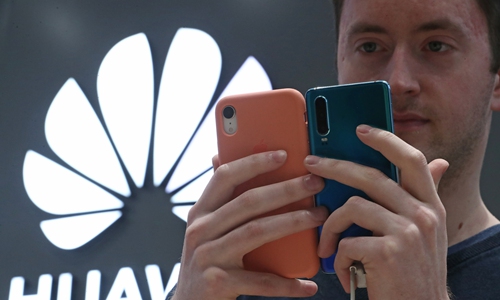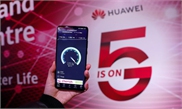US 'must work with Huawei' on 5G
Move already too late, American firms far behind: analysts

A customer views smartphones in a Huawei store at the Aviapark shopping mall in Moscow on Monday. Huawei plans to invest $10 million in Russia to support the Huawei Mobile Services ecosystem. Photo: VCG
The reported US move to let American companies work with Huawei on 5G standards is a belated one intended to push American enterprises to catch up in the 5G race, as they have to work with Huawei - which has become the largest contributor and an indispensable player in setting global 5G standards - before being marginalized, Chinese analysts said.
The US Department of Commerce is close to signing off on a new rule that would allow US-based companies to work with Huawei on setting standards for next-generation 5G networks, Reuters reported on Wednesday.
Rather than interpreting the move as a goodwill gesture, Chinese analysts said it only shows the US has realized the cost of refusing to cooperate with the world's largest patent contributor to the next-generation technology. US companies are falling far behind Huawei on 5G patents.
As of January 1, there were 21,571 5G-standard patent statements in the world and Huawei ranked first with 3,147, a report from German patent statistics company IPlytics showed. Next came Samsung with 2,795, ZTE with 2,561, LG Electronics with 2,300, Nokia with 2,149, and Ericsson with 1,494 - none of them from a US company.
"The rule will just have little impact on Huawei, and it cannot be seen as a major success - this is a decision US policymakers had to make," an industry insider surnamed Ma told the Global Times on Thursday.
The US Commerce Department placed Huawei on its Entity List last May, which not only restricted sales of US goods and technology to the Chinese technology giant but also "left companies uncertain about what technology and information their employees could share with Huawei," according to the Reuters report.
Huawei also played down the reported move on Thursday, saying that "the new rules are unrelated to questions about who Huawei can sell to or buy from. But lifting the ban should benefit everyone who cares about these technologies."
Xiang Ligang, a veteran telecoms industry analyst in Beijing, told the Global Times that the case shows that it will be difficult for Washington to continue its hardline strategy on Huawei due to the massive losses incurred by US companies. But a full-scale opening up of the US market to Huawei is unlikely.
The US has put pressure on Huawei mainly in three ways - to put it on the Entity List, thus barring it from using US chip components; to ban Huawei from using US software from suppliers such as Google; and to kick Huawei out of the 5G standard-setting process.
"The third strategy has obviously failed and backfired, but the first two are indeed pushing Huawei to adjust... for instance, to move its business focus back to China," Ma said.
But Ma noted that as China has been leading the world in an economic recovery while the coronavirus is brought under control, Huawei's stable business at home could also support its construction of the self-developed HMS ecosystem that aims to replace Google.
Huawei has previously said it will invest $200 million into its developer plan to promote the Kunpeng computing industry, strengthening its pace of building a competitive ecosystem that aims to replace Google amid the US ban. The company said in March that the number of its developers had reached 1.6 million over the past two years and could reach 5 million within five years.
"If Huawei's ecosystem can be accepted in the European market, the US' second strategy will also fail and it will be forced to lift the ban," Ma said. "But the US will certainly continue its crackdown, since even if Huawei cannot be killed, as long as it could be 'dragged down,' they may still have a chance in the coming 6G era."


